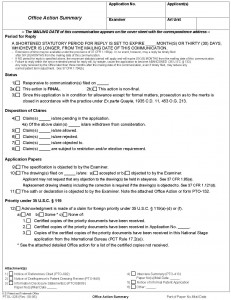Patent Application's Final Rejection
 Is a Patent Application’s Final Rejection Really Final? So you’ve filed a utility patent application on your invention. The expected Non-Final Office Action was answered. Confidence is high that a Notice of Allowance is just around the corner.
Is a Patent Application’s Final Rejection Really Final? So you’ve filed a utility patent application on your invention. The expected Non-Final Office Action was answered. Confidence is high that a Notice of Allowance is just around the corner.
But wait, the Patent Examiner issues a Second Office Action calling this one Final. The reason for the rejection is obviousness. The Examiner’s objections don’t seem to make any logical sense.
This scenario is becoming all too familiar. Just a few years ago, there were fewer applications receiving Second Office Actions. Now the number is up substantially. So what’s an inventor to do?
The first thing is to stay calm. If you have a good invention, and a qualified patent attorney/agent, then think of the patent process as a marathon. As with a marathon, everyone who “pushes through the wall” and finishes is a winner.
Thus, to answer the question – A final rejection does not have to be a final rejection. An inventor has options.
Here are the popular options used to maintain patent pending and fight for a patent:
1. Submit an After Final Amendment rebutting the Second Office Action. Although the Examiner is not required to look at it, many final arguments go through. The outcome can be improved if the Examiner agrees to discuss the situation with your attorney/agent, but the Examiner doesn’t have to. If you choose this approach, be sure to do it as early as possible in case the Examiner won’t consider the amendment, this will give you time to use another option without incurring Extension of Time fees. The Examiner issues what is known as an Advisory Action to formalize their response.
2. File a Request for Continuing Examination (RCE) and formally present your amendment to the Patent Office. Although similar to the previous option, filing your amendment with an RCE requires the Examiner to consider it. A further benefit is that the next Office Action, if there is one, cannot be Final.
3. File a Continuation. This will maintain the application’s original filing date and will buy time, typically so that an updated application can be prepared and filed. The Examiner’s objections don’t have to be answered. Any patentable references from the original application that are maintained will keep the early date.
4. File an Appeal which could take more than two years. With an Appeal, the existing Patent Examiner is replaced by the Board of Appeals & Interferences. Statistics show that about 40% of the Appeals are in the inventor’s favor. Costs for an Appeal can mount up.
The above four options all maintain the original filing date and keep the application patent pending. All of the responses for any of the options must be based on the application as originally filed.
There are other options:
5. An inventor could file a Continuation-in-Part (CIP) incorporating new features to improve the invention and to counter the Patent Office’s objections. The features from the first application will keep the original filing date while new features will have the date of the CIP filing. The Patent Office will treat the CIP as a new application with the time clock starting anew.
6. Re-file your invention as a new Design Patent Application based only upon the invention’s industrial and/or ornamental features. The existing utility application would be abandoned along with the priority date. A new patent pending period would start while the design application runs its course. A Design application typically takes about a year from filing to final determination. Keep in mind that a Utility patent is valid for 20 years from the original filing; whereas, a Design patent’s term is 14 from issuance with the patent pending period not included. Patent protection will be different because a Utility patent protects the utilitarian features of an invention while a Design patent protects exclusively what it looks like.
7. Abandoning the application is always an option. Patent pending will technically continue until the Examiner’s date of final rejection is reached. No patent will issue. When taking advantage of your options, be aware of the deadline established by the Examiner. The Second Office Action normally allows three months for a response to be filed. If additional time is needed, an inventor can buy three Extension Of Time months. The EOT fees presently are: 1-Month = $65.00; 2-Months = $245.00; and, 3-Months = $545.00. Following the three month extension, the patent application will finally go abandoned with no more extensions allowed.
When taking advantage of your options, be aware of the deadline established by the Examiner. The Second Office Action normally allows three months for a response to be filed. If additional time is needed, an inventor can buy three Extension Of Time months. The EOT fees presently are: 1-Month = $65.00; 2-Months = $245.00; and, 3-Months = $545.00. Following the three month extension, the patent application will finally go abandoned with no more extensions allowed.
Is there anything else that an inventor can do? The answer is yes – it’s a marathon you know. An abandoned application can possibly be revived (aka: resurrected from the dead). Resurrection is a topic for another time.
Inventors do have options to avoid a final rejection from becoming a final rejection.
Click Image for an example of:
Office Action Summary Form








